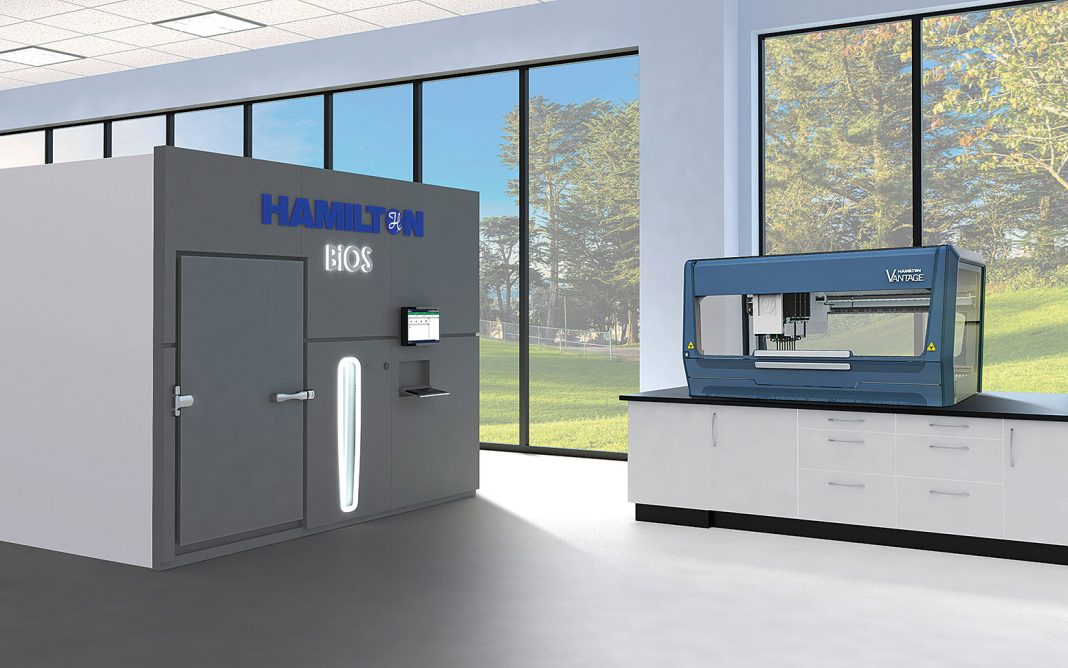Sponsored by

When considering the purchase of automated equipment, including automated sample storage systems, users typically start with a focus on today’s business needs. How much throughput? How much time? How much space? However, the greater question facing many biobanks today is that of financial sustainability.
Technology advances are helping generate massive amounts of data from samples and will continue to evolve. Decades-old legacy samples must be carefully protected, and new sample libraries are growing at a rapid rate. This market climate is forcing biobanks to look beyond the realm of scientific potential and into the realities (and intricacies) of sustaining long-term business success.
GEN sat down with Matthew Hamilton, president of Hamilton Storage, to talk about the role of automation relative to financial sustainability in biobanking.
GEN: How can biobanks leverage automation to help generate revenue streams?
Mr. Hamilton: First of all, many biobanks emerged to meet a research need without considering the business infrastructure necessary to support it long term. As the perspective shifts, it is critically important for biobanks to map out and routinely review their business model. Who are they, what do they want to achieve, and what are their core competencies? Economic provisions, including costs, funds, and revenue, should be characterized in the business model to support the logical plan toward long-term growth, success, and sustainability.
Now from a process and workflow perspective, biobanks may understand that automated systems increase sample throughput and reduce hands-on time and risks of human error, but it’s not always obvious how automation positively impacts the overall business of biobanking, including revenue generation. When we talk about revenue streams in this market, it’s typically relative to internal shared service operations within the parent organization or cohort, rather than bringing in significant profits.
An automated system provides valuable knowledge, streamlined process steps, and enhanced quality control measures that biobanks can use to attract third-party companies who lack the resources or capital to effectively manage their own growing sample libraries. This creates service-based revenue ranging from simply storing the samples over time, to storing and processing them. Automation also leads to meaningful economies of scale, so that the biobank can continue to grow, organically or through external services, without a significant increase in labor, materials, or equipment.
GEN: How does automation positively impact or reduce operating expenses?
Mr. Hamilton: It helps to consider sample costs across their entire lifespan, from collection to final disposal. There are so many elements, like recruiting, shipping, consumables, even administration, that can be cost drivers when it comes to biobanking. During processing and storage steps, as I said previously, automated systems can bring significant economies of scale to the equation. In a manual workflow, when more samples are added, more equipment and people are needed, and there’s more demand on the facilities. Conversely, an automated system performs repetitive, low-value tasks in a hands-free manner so that people can focus on high-value priorities, and expensive headcount isn’t required as sample capacity increases. Automation also makes it easier to transform non-labor expenses into a fixed-cost model, and to do so with minimal business disruption.
For the biobank, integrating automation starts with a business plan and what the the biobank wants to achieve operationally today and in the future. Based on that discussion, we create a roadmap to facilitate the growth over time, including the necessary labware and technologies along with any customization to suit the biobank’s particular process requirements. As the biobank nears the sample capacity upper limit or another relevant milestone, the system can be modularly expanded with minimal expense and minimal change to facilities demands such as electricity, air handling, and water.
Finally, automation offers a repetitive workflow while enabling the quality control. High-quality samples provide high-quality data, so if a biobank cannot confidently protect sample integrity, especially over long stretches of time, it is essentially destined to fail.
GEN: Is it more financially sustainable for research institutions and cohorts to maintain their own specialized biobanks, or outsource to an independent, general biobanking facility?
Mr. Hamilton: There’s no hard-and-fast answer to this; it really depends on what biobanks want to do with their business. This is why it’s so critical to think beyond the realm of research implications, as exciting as they may be. It also depends on how much control the researchers want over their sample libraries. Some feel like they can better control costs when they control the samples, rather than outsourcing them to a third party with a risk of price increases over time.
For those who opt to initiate an in-house or cohort biobank, I encourage them to start small and prove out a business model and internal process, including upstream and downstream steps. Then plan the progression to full production, including flexibility for changes like the addition of a new assay or container type. By doing so, they can simply scale up instead of recreating the wheel as they grow. In addition to benefiting business operations, this method is attractive from a grant award perspective because it’s a proven concept rather than an untested theory.
Matthew Hamilton is president of Hamilton Storage, based in Franklin, MA.
Hamilton Storage Enables Long-Term Biobanking Success
Bring financial sustainability to your biobanking business with Hamilton Storage. Visit www.hamiltoncompany.com/GEN to learn how Hamilton supports preeminent biobanks around the world, or email [email protected] to initiate a discussion about your unique biobanking goals. “




